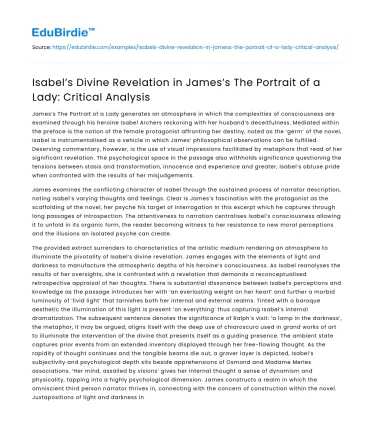James’s The Portrait of a Lady generates an atmosphere in which the complexities of consciousness are examined through his heroine Isabel Archers reckoning with her husband’s deceitfulness. Mediated within the preface is the notion of the female protagonist affronting her destiny, noted as the ‘germ’ of the novel, Isabel is instrumentalised as a vehicle in which James’ philosophical observations can be fulfilled. Deserving commentary, however, is the use of visual impressions facilitated by metaphors that read of her significant revelation. The psychological space in the passage also withholds significance questioning the tensions between stasis and transformation, innocence and experience and greater, Isabel’s obtuse pride when confronted with the results of her misjudgements.
James examines the conflicting character of Isabel through the sustained process of narrator description, noting Isabel’s varying thoughts and feelings. Clear is James’s fascination with the protagonist as the scaffolding of the novel, her psyche his target of interrogation in this excerpt which he captures through long passages of introspection. The attentiveness to narration centralises Isabel’s consciousness allowing it to unfold in its organic form, the reader becoming witness to her resistance to new moral perceptions and the illusions an isolated psyche can create.
Save your time!
We can take care of your essay
- Proper editing and formatting
- Free revision, title page, and bibliography
- Flexible prices and money-back guarantee
The provided extract surrenders to characteristics of the artistic medium rendering an atmosphere to illuminate the pivotality of Isabel’s divine revelation. James engages with the elements of light and darkness to manufacture the atmospheric depths of his heroine’s consciousness. As Isabel reanalyses the results of her oversights, she is confronted with a revelation that demands a reconceptualised retrospective appraisal of her thoughts. There is substantial dissonance between Isabel’s perceptions and knowledge as the passage introduces her with ‘an everlasting weight on her heart’ and further a morbid luminosity of ‘livid light’ that tarnishes both her internal and external realms. Tinted with a baroque aesthetic the illumination of this light is present ‘on everything’ thus capturing Isabel’s internal dramatization. The subsequent sentence denotes the significance of Ralph’s visit: ‘a lamp in the darkness’, the metaphor, it may be argued, aligns itself with the deep use of chiaroscuro used in grand works of art to illuminate the intervention of the divine that presents itself as a guiding presence. The ambient state captures prior events from an extended inventory displayed through her free-flowing thought. As the rapidity of thought continues and the tangible beams die out, a graver layer is depicted, Isabel’s subjectivity and psychological depth sits beside apprehensions of Osmond and Madame Merles associations. ‘Her mind, assailed by visions’ gives her internal thought a sense of dynamism and physicality, tapping into a highly psychological dimension. James constructs a realm in which the omniscient third person narrator thrives in, connecting with the concern of construction within the novel. Juxtapositions of light and darkness induce a space that is formulated through imagery derivative of James’s fascination with narrative art.
The narrator examines the presence of good and evil in the complicated growth of Isabel’s perceptions and awareness. Isabel’s initial passivity is heightened in her melodramatic realisation. The series of misjudgements lead to the collapse of her world and it is such ignorance in a prodigy like Isabel that reeks of wilful egotism. Upon the recapitulations of warnings granted to her by Ralph in the garden in Florence she is bewildered as the narrator states ‘How could he have known? What a mystery, what a wonder of wisdom!’. Ralph imposes himself as an ethical compass, his presence exuding familiarity comparable to that of a brother. Sensory language gives access the reader access to Isabel’s most basic instincts suggesting that her customary senses (auditory, visual, tactile) are now awakened and wildly stimulated by the world around her: ‘to see the place, to hear his voice, to feel the warm, sweet air.’ This anticipated revelation and transformation of self however falls short of completion. This revelation on the contrary portrays Isabel with audacious optimism and forgiveness, despite the opportunity to grant moral detachment in order to embrace this newly amalgamated perspective. This is recognisable as a means of denial to the change this perspective would bring. In surface examination of a pretense to Ralph it is evident her dismissal is merely her egoism feigning joyfulness as a means of distraction. This is prevalent when her self-importance denies defeat, through an extravagant ruse she believes is a “kindness”. It can be considered as a kindness or a “for a single instant a dupe” with a pitiless receiver such as Isabel. The narrator continues to denote her consideration not seeking to ‘to flaunt her happiness in his face.’. Despite Isabel’s jarring superficialities the reader is exposed to an element of reality. To avoid disastrous spiralling the mind will often conceal wrong doing with unwavering optimism, although inescapable for Isabel when later isolated in the saloon. These insights into her metamorphosis strategically reflect the valid fluctuations and resistances the human psyche undergoes in substantial revelation such as this.
This passage captures the significance of this pivotal chapter, this realisation a turn in her story that asks the audience to question the young lady’s desire for incredulous independence. The use of the sagacious third person narrator presents itself as an essential tool in the manifestation of psychological space in this passage. Potent juxtapositions highlight to the reader revelation, transcending through Isabel’s psyche. James deconstructs the human consciousness, touching on realities of the ego however never resorts to summarising its full quintessence. The use of artistic expression furthering the readers understanding of the visions that extend from the mind.






 Stuck on your essay?
Stuck on your essay?

